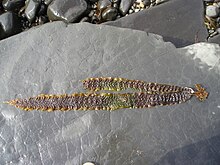Saccharina latissima
| Saccharina latissima | |
|---|---|
 |
|
| Saccharina latissima | |
| Scientific classification | |
| (unranked): | SAR |
| Superphylum: | Heterokonta |
| Class: | Phaeophyceae |
| Order: | Laminariales |
| Family: | Laminariaceae |
| Genus: | Saccharina |
| Species: | S. latissima |
| Binomial name | |
|
Saccharina latissima (L.) C.E. Lane, C. Mayes, Druehl, et G. W. Saunders |
|
| Synonyms | |
|
|
Saccharina latissima is a brown algae (class Phaeophyceae), of the family Laminariaceae. It is also known by the common names sea belt and Devil's apron, due to its shape. It is found in the north east Atlantic Ocean and the Barents Sea south to Galicia in Spain. It is not found in the Bay of Biscay but is common round the coasts of the British Isles. The species is found at sheltered rocky seabeds.
S. latissima is a yellowish brown colour with a long narrow, undivided blade that can grow to 5 metres (16 ft) long and 20 centimetres (7.9 in) wide. The central band is dimpled while the margins are smoother with a wavy edge. The frond is attached to the rock by stout rhizoids about 5 mm in diameter in the intertidal and sublittoral zones by a claw-like holdfast and a short, pliable, cylindrical stipe.
S. latissima is an ecologically important system. It is a primary producer, delivering plant material to the coastal food web. The three-dimensional forests also serve as a habitat for animals, resulting in a high biodiversity. Fish, shellfish and other animals get food and hiding places within these forests.
In 2004, scientists reported a loss in sugar kelp at 80% of the locations in the Skagerrak and 40% of the locations at the West coast of Norway. The reasons for this loss are not fully understood, but the increase in ocean temperature, high levels of nutrients and the reduction in animal species feeding off the filamentous algae are suggested as the most likely reasons.
...
Wikipedia
